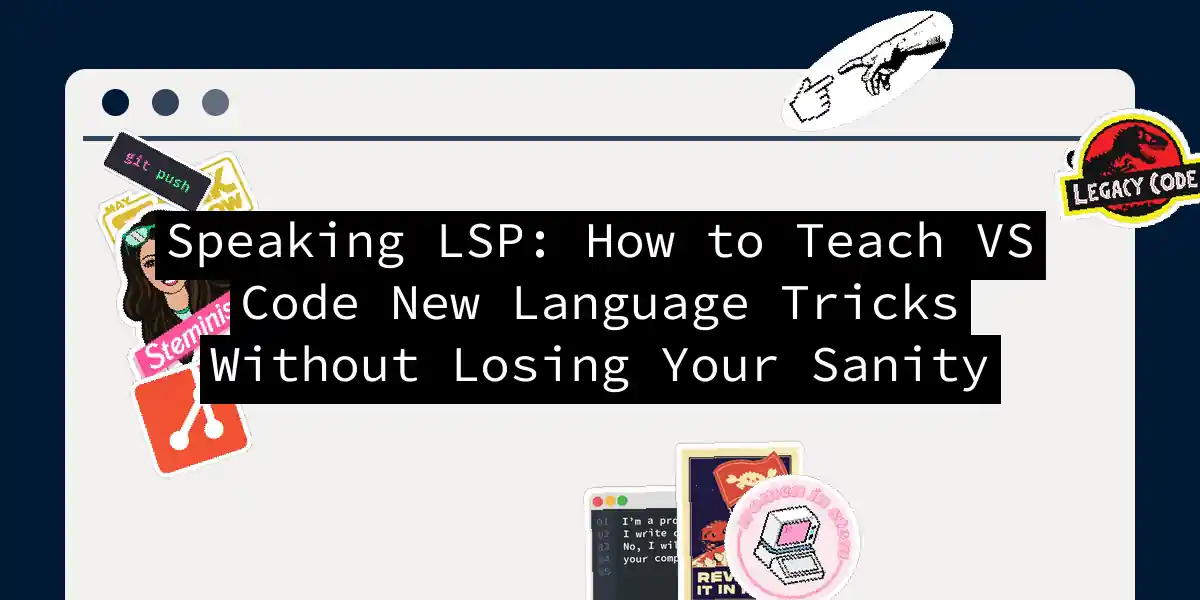Picture this: You’re trying to build the world’s first Klingon IDE in VS Code, but your extension keeps crashing every time someone types “Heghlu’meH QaQ jajvam!” (That’s “Today is a good day to die!” for us mere mortals). Enter the Language Server Protocol - your universal translator for code intelligence. Let’s build something slightly more practical instead.
Why LSP Beats Teaching Your Editor Klingon
The Language Server Protocol (LSP) is like Switzerland for programming tools - it establishes neutral ground where editors and language analyzers can meet without starting IDE wars. Here’s why it rocks:
- Single Server, Multiple Editors: Write once, run in VS Code, Vim, and even that hipster editor written in Rust
- Crash Containment: Isolate your language logic in a separate process (so your users don’t lose work when your regex fails)
- Protocol Buffers > Telepathy: Structured communication beats mind-reading every time
Crafting Your Language Sidekick
1. Client Setup: The VS Code Extension
Let’s build the client that’ll whisper sweet nothings to our server:
// package.json
{
"activationEvents": ["onLanguage:myLang"],
"dependencies": {
"vscode-languageclient": "^8.0.0"
}
}
// src/extension.ts
import * as vscode from 'vscode';
import { LanguageClient } from 'vscode-languageclient';
export function activate(context: vscode.ExtensionContext) {
const serverOptions = {
command: 'node',
args: [context.asAbsolutePath('server.js')]
};
const clientOptions = {
documentSelector: [{ scheme: 'file', language: 'myLang' }],
synchronize: {
fileEvents: vscode.workspace.createFileSystemWatcher('**/*.mylang')
}
};
const client = new LanguageClient(
'myLangServer',
'My Language Server',
serverOptions,
clientOptions
);
context.subscriptions.push(client.start());
}
2. Server Implementation: The Brain in a Jar
Our server needs to handle requests like a coffee-fueled barista:
// server.js
const { createConnection, TextDocuments } = require('vscode-languageserver/node');
const { TextDocument } = require('vscode-languageserver-textdocument');
const connection = createConnection();
const documents = new TextDocuments(TextDocument);
connection.onInitialize(() => ({
capabilities: {
textDocumentSync: 1, // Full sync mode
completionProvider: { resolveProvider: true }
}
}));
documents.onDidChangeContent(change => {
const diagnostics = [];
const text = change.document.getText();
// Super advanced analysis: Check for forbidden words
if (text.includes('COBOL')) {
diagnostics.push({
severity: 1, // Error
range: { start: { line: 0, character: 0 }, end: { line: 0, character: 5 } },
message: 'COBOL detected! Initiating system purge...'
});
}
connection.sendDiagnostics({ uri: change.document.uri, diagnostics });
});
documents.listen(connection);
connection.listen();
Bad Code?} D -- Yes --> E[Send Error Diagnostic] D -- No --> F[Send Update] E --> G[Display Squiggles] F --> H[Update Cache]
Debugging Your Protocol Child
When things go wrong (and they will), try these sanity checks:
- The Telepathy Test: Run
lsp-wiresharkto sniff LSP traffic - Crash Course: Look for server crashes in VS Code’s Output panel
- Protocol Gym: Validate JSON-RPC messages using LSP inspector
From Prototype to Production
Want to go from “it works on my machine” to “works in production”? Level up with:
- Incremental Sync: Use
textDocumentSync: 2for partial updates - Memory Management: Implement cancellation tokens for long-running operations
- Smart Caching: Store ASTs instead of raw text for faster analysis Remember, building a language server is like raising a child – it will make mistakes, occasionally embarrass you in public, but with enough care, it might grow into something useful. Now go forth and make that Klingon IDE a reality! Qapla'!
